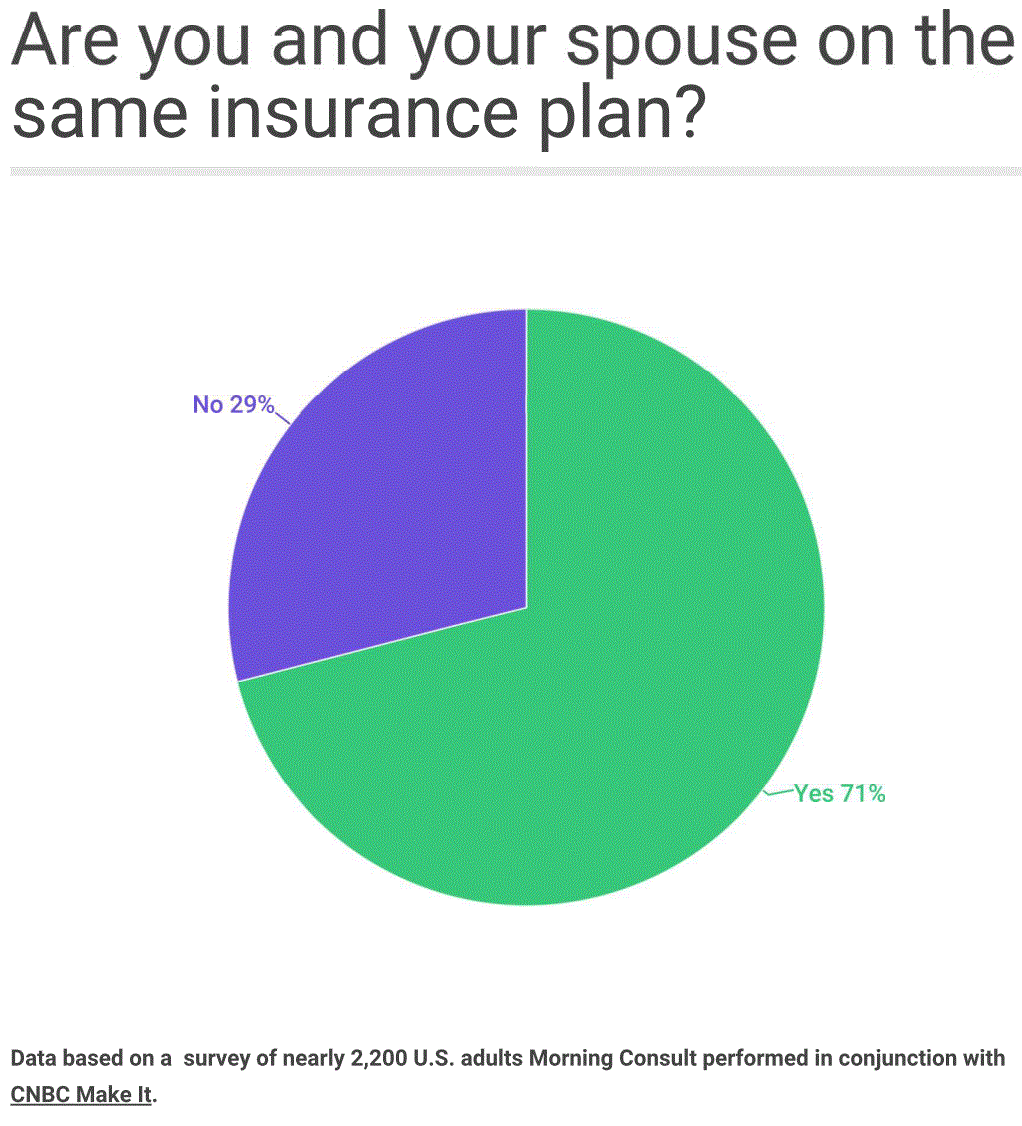
Published Fri, Nov 8 2019 - CNBC
Megan Leonhardt
When couples get married, many times there's a conversation about combining everything from bank accounts to last names. But while picking one health insurance plan for both of you may seem like a convenient solution, experts say this strategy doesn't make sense for most couples.
The question around how to structure your insurance coverage if you're a couple is coming up more and more now, Jonathan Wiik, principal of health-care strategy at TransUnion Healthcare, tells CNBC Make It. That's because there are higher and higher out-of-pocket expenses that patients need to shoulder, so consumers are looking very closely at how insurance coverage works. On average, consumers are responsible for about 30% of their medical bills, he says.
When it comes to shared vs. solo participation, about a third of American couples, 29%, are on separate health insurance plans, according to a survey of nearly 2,200 U.S. adults Morning Consult performed in conjunction with CNBC Make It. That's smart, Buckey says. "A lot of times, it doesn't make sense to have everyone on one plan," she says.
Some couples may not have a choice when it comes to their health insurance options. They may opt for coverage with one spouse if their partner is a freelance or contract employee without access to employer-based health insurance. Paying a spousal surcharge or higher premium is generally less expensive than getting individual insurance.
Meanwhile, about 11% of companies do not allow spousal enrollment if they have other coverage, according to the Kaiser Family Foundation. For those employers who do allow enrollment, 33% charge a spousal surcharge, which averages $1,200 a year. That's roughly the same amount as the average employees pays in premiums each year, so there's no real cost savings.
It's "one of those little gotchas" that's showing up more and more, says Kim Buckey, vice president of of client services at DirectPath, an organization that guides employees to make better health care decisions.
You may think that you're avoiding paying two premiums, but if one partner has access to an employer-based insurance plan that's less than $100 a month, you're probably paying more for the convenience of being on the same plan. This is particularly true if one partner is in good health and can opt into a high-deductible plan with low monthly costs.
It's important to keep in mind that health insurance through your employer is a benefit. If you do opt to have everyone on one plan, that may mean you or your partner will be losing out. That's because employers pay a portion of your health insurance and that's factored into the salary that they offer you.
The average annual premium for an employer-based insurance plan is $7,188 for an individual, according to the Kaiser Family Foundation's annual employer health benefits survey. Workers pay an average of $1,242 toward the cost, which means employers pay the difference, roughly $6,000 a year — money you or your partner are leaving on the table if you opt to only do one plan.
It used to be that some employers provided top-notch health insurance plans, so much so that it was worth paying the spousal surcharge to get access to better benefits for both partners. Those days are over, Buckey says. "It's unlikely there's going to be a huge difference [in benefits]," Buckey says.
Overall, more and more plans are covering virtually identical services. "Not many employers are offering the ultra-rich plans of olden days," Buckey says. Skip the spousal surcharge and simply opt for your own plan.
That said, if you have a unique situation, it may be worth doing a deep dive into each partner's health options. If there is a benefit or treatment option that one employer-based plan covers and the other does not, it may make sense. Applied behavior analysis, or ABA therapy, used for autism was not covered by a lot of employer-based plans until recently, for example.
It's also worth noting that using a spouse's plan as a secondary insurance provider is a waste of money unless you can join for free. Buckey says that it rarely works out that you save money if you have to pay spousal surcharges for access to both plans.
If you and your partner's employer-based health options are both set up as a coinsurance plans, where the patient is responsible for 20% of the medical bill after hitting the deductible, when you go to coordinate payments between the two plans, typically there is absolutely no benefit to you for having that additional coverage, she says.
"You're basically paying for something that you're not getting any value out of," Buckey says.
One reason you may want to consider a single plan, Wiik says, is if you have a family and you're likely to hit the family out-of-pocket maximum.
When you're on an insurance plan, all of your payments — the deductible, coinsurance and copays — all go toward the out-of-pocket maximum. If you're on a family plan, everything you've paid for all the members on the plan goes toward it and once you hit the maximum, the insurance company pays 100% of the costs for any covered services.
"It's a math problem," Wiik says. Ask yourself: How many times do you or your kids go to the doctor? Are you having a baby? How many times do you think you might need to visit the emergency room this year?
For 2020, the out-of-pocket maximum is $16,400 for family plans and $8,200 for individual plans, according to insurance marketplace Policygenius. If you're likely to hit the max, it may make sense to have everyone on one plan instead of paying two premiums, even if you do have to pay slightly more for spousal surcharges.
"You've got to calculate the over-under from a holistic standpoint," Wiik says.